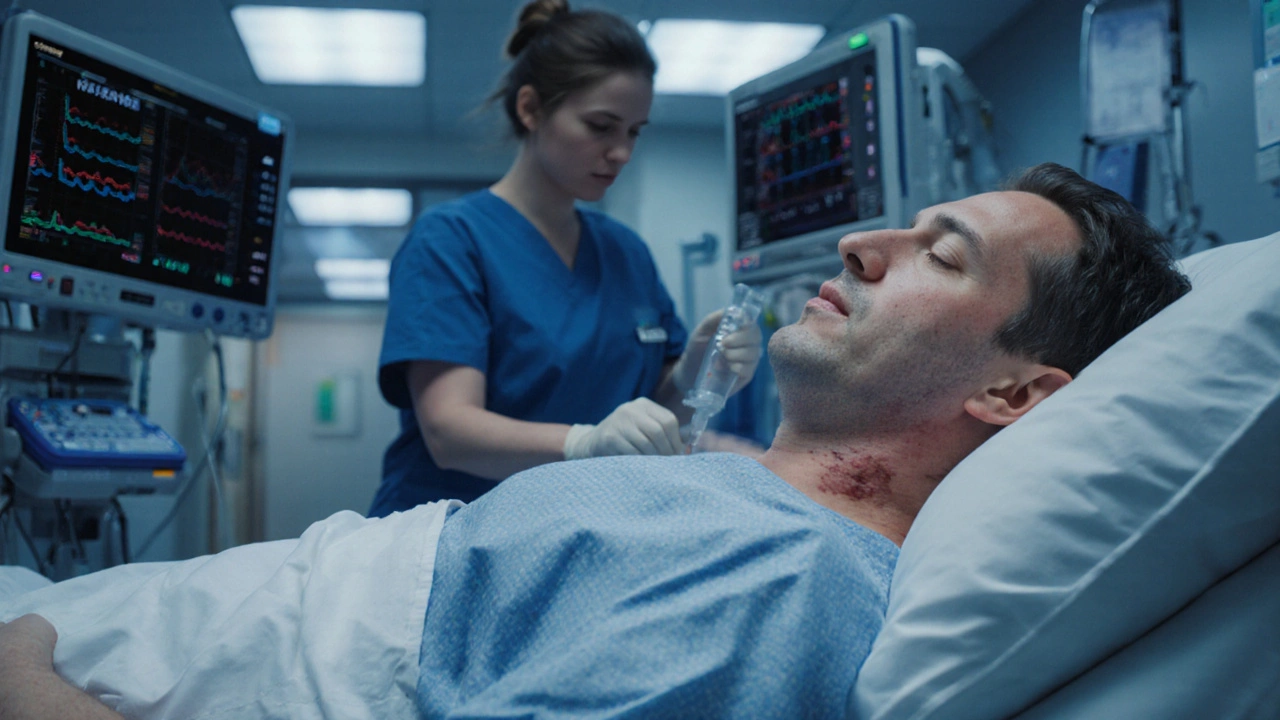Surgery Recovery Timeline Calculator
Enter your selections and click "Calculate Estimated Recovery Time" to see personalized recovery estimates based on surgery type and patient factors.
Quick Takeaways
- Organ transplants, especially liver and multiple‑organ transplants, typically need the longest recovery - often 6‑12 months.
- Complex spine and brain surgeries follow, with rehab periods of 3‑9 months.
- Recovery length depends on invasiveness, patient health, and post‑op complications.
- Knowing the timeline helps you plan finances, work, and support networks.
- Practical tips - early physiotherapy, nutrition, and realistic goal‑setting - can shorten the hardest weeks.
TL;DR: The surgeries that clock the longest recovery clocks are liver transplants and multiple‑organ transplants, usually demanding 6‑12 months before most daily activities feel normal. Major spine fusions, open brain surgeries, and extensive orthopedic reconstructions sit a step behind, needing 3‑9 months of rehab. Recovery speed hinges on how invasive the procedure is, the patient’s baseline health, and how well complications are managed.
What Determines Recovery Time?
When you hear “recovery time” it’s really a mix of three things: tissue healing, rehabilitation, and getting back to life’s routine. The more tissue you cut or replace, the longer the body needs to rebuild. Add in a delicate organ like the liver, and you’re looking at weeks of intensive monitoring before even stepping out of the ICU.
Age, nutrition, pre‑existing conditions (diabetes, heart disease), and whether you quit smoking all tilt the scales. Even the surgical technique matters - minimally‑invasive laparoscopy can shave weeks off a recovery compared with an open‑cavity approach.

Surgeries Known for the Longest Recovery
Liver transplant is a life‑saving operation where a diseased liver is replaced with a donor organ, requiring extensive post‑op monitoring and gradual immunosuppressive therapy. Most patients spend 1‑2 weeks in the hospital, then face a 6‑12 month period of wound care, physiotherapy, and blood‑test checks before they can return to a regular job.
Multiple‑organ transplant is the simultaneous replacement of two or more organs (commonly heart and liver or kidney and pancreas), demanding the longest hospital stay and the most rigorous follow‑up regimen. Recovery stretches to a year or more, as the immune system juggles several new organs and the patient must master a complex medication schedule.
Heart transplant is the surgical swapping of a diseased heart for a donor heart, with an intensive care period of 7‑10 days followed by a prolonged phase of immunosuppression and cardiac rehab. Full functional recovery typically hits the 9‑12 month mark, especially for patients who need to rebuild stamina after years of limited heart output.
Spinal fusion is a procedure that joins two or more vertebrae using bone grafts or metal implants to eliminate motion and relieve pain. Because the spine is a load‑bearing structure, patients often need 3‑6 months of brace wear, physical therapy, and gradual activity increase before they can lift heavy objects.
Craniotomy (open brain surgery) is the removal of a portion of the skull to access the brain for tumor removal, aneurysm repair, or epilepsy treatment. Post‑op brain swelling, scar tissue, and neuro‑rehab can push the recovery window to 4‑9 months, depending on the area operated on.
Pancreaticoduodenectomy (Whipple procedure) is a complex operation to remove the head of the pancreas, part of the small intestine, gallbladder, and bile duct, often done for cancer. The sheer number of reconnections means patients stay in hospital for 2‑3 weeks and spend 4‑6 months regaining digestive normalcy.
Total hip replacement is the surgical exchange of a damaged hip joint with a prosthetic, requiring bone integration and muscle retraining. While many report walking unaided within 6‑8 weeks, full strength and range of motion can take up to 6 months.
Kidney transplant is the implantation of a healthy donor kidney, which, despite being less invasive than liver or heart transplants, still demands 3‑6 months of careful monitoring. Immunosuppressant side‑effects and infection risk extend the convalescence period.
Side‑by‑Side Comparison
| Procedure | Typical Hospital Stay | Full Recovery Range | Key Rehabilitation Focus |
|---|---|---|---|
| Liver transplant | 10‑14 days | 6‑12 months | Immunosuppression management, wound care, endurance training |
| Multiple‑organ transplant | 2‑3 weeks | 9‑18 months | Complex medication regimen, organ‑specific rehab |
| Heart transplant | 7‑10 days | 9‑12 months | Cardiac rehab, strength building, monitoring rejection |
| Spinal fusion | 3‑5 days | 3‑6 months | Core stabilization, gradual load‑bearing |
| Craniotomy | 4‑7 days | 4‑9 months | Neuro‑rehab, cognitive therapy, balance training |
| Whipple procedure | 12‑20 days | 4‑6 months | Digestive adaptation, nutritional support |
| Total hip replacement | 2‑4 days | 4‑6 months | Gait training, hip strengthening |
| Kidney transplant | 5‑7 days | 3‑6 months | Renal function monitoring, infection prevention |

Why Some Surgeries Take So Long
Three main forces push recovery out:
- Extent of tissue trauma: Cutting through multiple muscle layers, bone, or major blood vessels triggers a cascade of inflammation. The body needs weeks to resolve swelling before it can safely start movement.
- Organ complexity and function: Replacing a vital organ means the immune system must be coaxed into accepting the new tissue. Immunosuppressant drugs have side‑effects that slow wound healing.
- Complication risk: Infections, graft rejection, or nerve damage add extra weeks of antibiotics, additional surgeries, or specialized rehab.
Understanding these drivers helps patients and families set realistic expectations and prepare the right support.
How to Make a Long Recovery More Manageable
- Start nutrition early: Protein‑rich meals, omega‑3 fatty acids, and adequate calories give the body building blocks for tissue repair.
- Engage a multidisciplinary team: Surgeons, physiotherapists, dietitians, and mental‑health counselors coordinate to keep you moving without over‑doing it.
- Set micro‑goals: Instead of “I’ll be back to work in 12 months,” aim for “I’ll walk 100 meters unaided by week 4.” Small wins keep morale high.
- Stay on top of medication: Use a pill organizer and set phone reminders. Missing an immunosuppressant dose can trigger rejection and add months.
- Plan finances ahead: Long hospital stays and home‑care aides cost money. Check your private health insurance coverage and explore government support for chronic post‑op care.
Frequently Asked Questions
Which surgery has the absolute longest recovery period?
A multiple‑organ transplant - often a heart‑plus‑liver combo - tops the list. Recovery can stretch beyond 18 months because the body must accept several new organs while fighting infections and managing a heavy drug regimen.
Is a liver transplant always slower to recover than a kidney transplant?
Yes, on average. The liver has a massive metabolic role and its surgery involves larger incisions, more blood loss, and a longer immunosuppression period. Kidney transplants typically heal faster, with many patients returning to light activity within two months.
Can minimally invasive techniques shorten recovery for these long‑haul surgeries?
For some procedures - like laparoscopic liver resections - the stay is reduced by a few days, but the core recovery (immune adjustment, organ integration) remains lengthy. Minimally invasive methods mainly improve early‑post‑op comfort rather than the months‑long healing curve.
What are the biggest red‑flags that a recovery is taking longer than expected?
Persistent fever, wound drainage, sudden weight loss, unexplained pain, or lab results showing organ dysfunction are warning signs. If any appear, contact your surgical team immediately - early intervention can prevent a setback that adds weeks or months.
How can families help during a protracted recovery?
Provide practical aid (meal prep, transportation), keep track of medication schedules, attend physiotherapy sessions for encouragement, and monitor mental health. A supportive environment cuts stress, which in turn speeds tissue repair.




